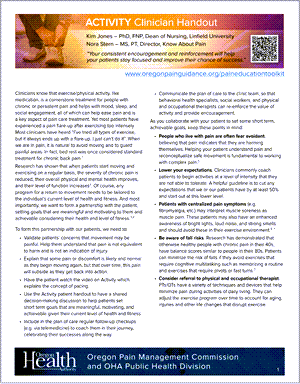HOW PAIN AND ACTIVITY WORK TOGETHER
When your patients move less and less, their brain becomes accustomed to that decrease in activity. As the brain learns pain, more and more activity becomes connected with the pain response even when they are doing things that aren’t harmful.
WHAT CAN MAKE THINGS BETTER
Encouraging your patients to increase their activity helps their brain rewire itself so that they can move more easily. Some pain or discomfort as they get moving again is normal. They may be a little sore, but they are safe. Over time, they will become more active and healthy and their pain will likely decrease.
 VIDEO
VIDEO
The Activity video has five sections:
- Does activity helps with pain or makes pain worse?
- Increasing activity is essential to improve, but learn to pace yourself
- Steps and plans to get more active
- Testimonials from patients
- Setting some personal goals
The video contains all the educational content, so be sure to have the patient watch the entire video.
 HANDOUT
HANDOUT
Download the handout to learn about:
- How Exercise Reduces Chronic Pain
- Making Activity Recommendations for Your Patients
- Helping Your Patients Set Achievable Activity Goals
 RESOURCES
RESOURCES
- Physical Activity and Exercise for Chronic Pain in Adults: An Overview of Cochrane Reviews
- Exercise and Chronic Pain
- Physical Exercise as Non-pharmacological Treatment of Chronic Pain: Why and When
- Exercise Interventions in Fibromyalgia: Clinical Applications from the Evidence
- Exercise for Chronic Musculoskeletal Pain: A Biopsychosocial Approach
- Exercise, Not to Exercise, or How to Exercise in Patients with Chronic Pain? Applying Science to Practice
- Postural Control Deficits in People with Fibromyalgia: A Pilot Study
- Follow-up of Yoga of Awareness for Fibromyalgia: Results at 3 Months and Replication in the Wait-list Group
- Facilitators and Barriers to Physical Activity in People with Chronic Low Back Pain: A Qualitative Study


